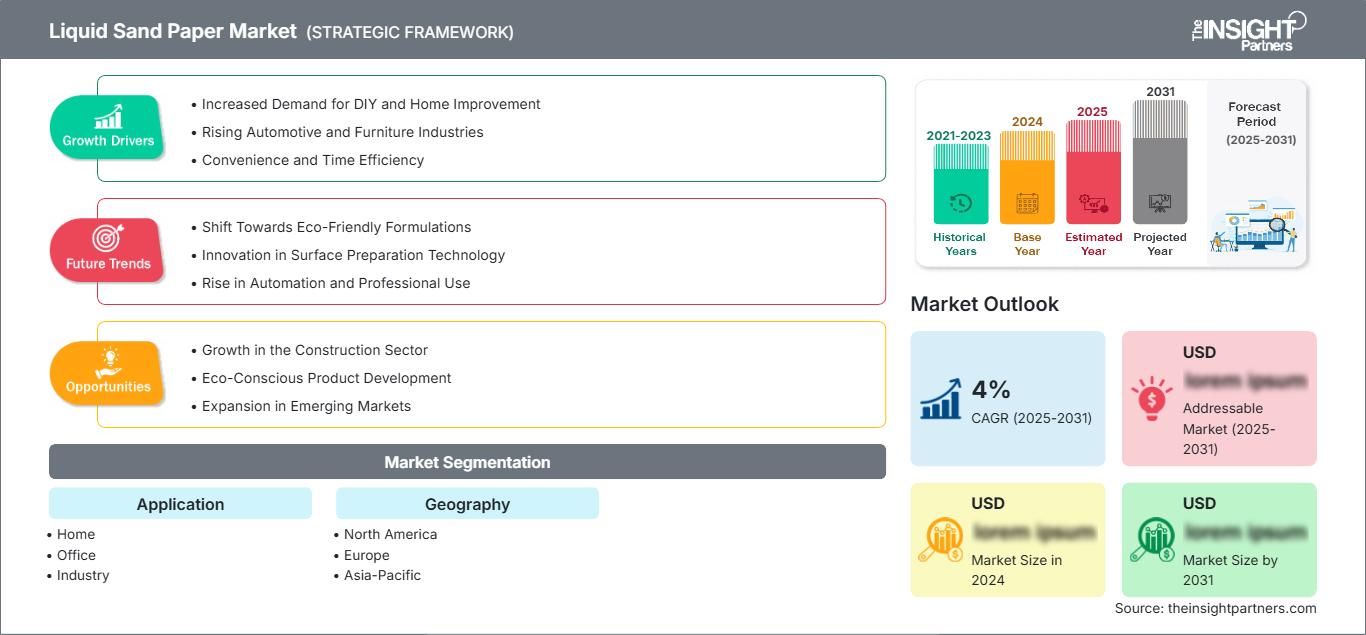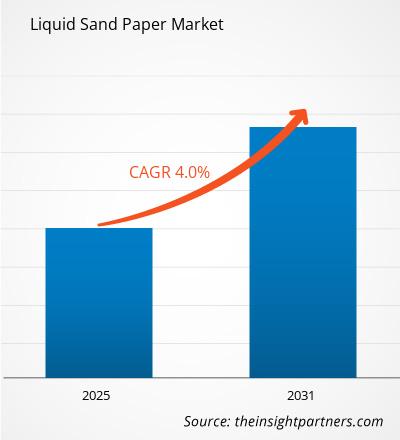Der Markt für Flüssigsandpapier wird voraussichtlich zwischen 2025 und 2031 eine durchschnittliche jährliche Wachstumsrate (CAGR) von 4 % verzeichnen, wobei die Marktgröße von XX Millionen US-Dollar im Jahr 2024 auf XX Millionen US-Dollar im Jahr 2031 anwachsen wird.
Der Bericht ist nach Anwendung (Heim, Büro, Industrie) segmentiert. Die globale Analyse ist weiter nach regionaler Ebene und den wichtigsten Ländern aufgeschlüsselt. Die globale Analyse ist weiter nach regionaler Ebene und den wichtigsten Ländern aufgeschlüsselt. Der Umfang umfasst die Marktgröße und -prognose auf globaler, regionaler und Länderebene für alle wichtigen Marktsegmente. Der Bericht bietet den Wert in USD für die oben genannte Analyse und Segmente. Der Bericht bietet wichtige Statistiken zum Marktstatus der wichtigsten Marktteilnehmer und bietet Markttrends und -chancen.
Zweck des Berichts
Der Bericht „Flüssigsandpapier-Markt“ von The Insight Partners zielt darauf ab, die aktuelle Situation und das zukünftige Wachstum sowie die wichtigsten treibenden Faktoren, Herausforderungen und Chancen zu beschreiben. Dies bietet verschiedenen Geschäftspartnern Einblicke, beispielsweise:
- Technologieanbieter/-hersteller: Um die sich entwickelnde Marktdynamik zu verstehen und die potenziellen Wachstumschancen zu kennen, sodass sie fundierte strategische Entscheidungen treffen können.
- Investoren: Um eine umfassende Trendanalyse hinsichtlich der Marktwachstumsrate, der finanziellen Marktprognosen und der Chancen entlang der Wertschöpfungskette durchzuführen.
- Regulierungsbehörden: Um Richtlinien und Überwachungsaktivitäten auf dem Markt zu regulieren, mit dem Ziel, Missbrauch zu minimieren, das Vertrauen der Investoren zu wahren und die Integrität und Stabilität des Marktes aufrechtzuerhalten.
Anwendung zur Marktsegmentierung für flüssiges Sandpapier
- Zuhause
- Büro
- Industrie
Sie erhalten kostenlos Anpassungen an jedem Bericht, einschließlich Teilen dieses Berichts oder einer Analyse auf Länderebene, eines Excel-Datenpakets sowie tolle Angebote und Rabatte für Start-ups und Universitäten.
Markt für flüssiges Sandpapier: Strategische Einblicke

-
Holen Sie sich die wichtigsten Markttrends aus diesem Bericht.Dieses KOSTENLOSE Beispiel umfasst Datenanalysen, die von Markttrends bis hin zu Schätzungen und Prognosen reichen.
Wachstumstreiber für Flüssigschleifpapier
- Steigende Nachfrage im Heimwerken und bei Heimwerkerprojekten: Die wachsende Beliebtheit von Heimwerkerprojekten und Renovierungen treibt die Nachfrage nach Flüssigschleifpapier an. Verbraucher und Profis verwenden Flüssigschleifpapier, um Oberflächen einfach für das Streichen, Beizen oder Lackieren vorzubereiten, wodurch ein starkes Wachstumspotenzial im Markt für Produkte zur Oberflächenvorbereitung entsteht.
- Aufstrebende Automobil- und Möbelindustrie: Die Automobil- und Möbelindustrie sind wichtige Treiber des Marktes für Flüssigschleifpapier. Flüssigschleifpapier wird häufig zum Nachbearbeiten, Glätten und Vorbereiten von Oberflächen bei Autoteilen, Möbeln und Schränken verwendet, um gleichmäßige Oberflächen zu gewährleisten und zum Marktwachstum in diesen wichtigen Sektoren beizutragen.
- Komfort und Zeitersparnis: Flüssigschleifpapier bietet im Vergleich zu herkömmlichem Schleifpapier eine schnellere und weniger arbeitsintensive Methode zur Oberflächenvorbereitung. Seine Fähigkeit, Oberflächen ohne manuelles Schleifen zu glätten, treibt seine Verbreitung in verschiedenen Branchen voran, in denen Effizienz und Benutzerfreundlichkeit entscheidende Faktoren bei der Oberflächenbearbeitung sind.
Zukünftige Trends im Markt für Flüssigschleifpapier
- Umstellung auf umweltfreundliche Rezepturen: Mit zunehmendem Umweltbewusstsein von Verbrauchern und Industrie gibt es einen wachsenden Trend zu umweltfreundlichen Rezepturen für Flüssigschleifpapier. Hersteller konzentrieren sich darauf, schädliche Chemikalien in Produkten zu reduzieren und sicherere, ungiftige Alternativen anzubieten, die dennoch eine hervorragende Oberflächenvorbereitung bieten und nachhaltiger sind.
- Innovation in der Oberflächenvorbereitungstechnologie: Der Markt für Flüssigschleifpapier profitiert von kontinuierlichen Innovationen in der Oberflächenvorbereitungstechnologie. Neue Rezepturen bieten verbesserte Effizienz, stärkere Haftung und verbesserte Leistung für verschiedene Materialien, von Metallen bis hin zu Holz. Diese Innovationen ermöglichen es dem Produkt, vielfältigere Branchen zu bedienen, was seine Attraktivität und seinen Marktanteil steigert.
- Zunehmende Automatisierung und professionelle Nutzung: Mit fortschreitender Automatisierung und industriellen Prozessen gibt es einen zunehmenden Trend zur Verwendung von Flüssigschleifpapier in automatisierten Anwendungen für eine gleichmäßige Oberflächenbearbeitung. Die Fähigkeit des Produkts, schnell und gleichmäßig aufgetragen zu werden, führt zu seiner weiten Verbreitung in professionellen, hochpräzisen Bereichen wie der Automobilherstellung und der Möbelrestaurierung.
Marktchancen für Flüssigschleifpapier
- Wachstum im Bausektor: Das Wachstum im Wohnungs-, Gewerbe- und Industriebau bietet eine bedeutende Chance für den Markt für Flüssigschleifpapier. Mit der steigenden Nachfrage nach Oberflächenvorbereitung bei Neubauten und Sanierungen können Hersteller ihr Produktangebot erweitern, um dem Bedarf der Bauindustrie an effizienten, hochwertigen Lösungen für die Oberflächenbearbeitung gerecht zu werden.
- Umweltbewusste Produktentwicklung: Da Nachhaltigkeit für Verbraucher und Industrie immer wichtiger wird, bietet sich die Möglichkeit, Flüssigschleifpapier mit biologisch abbaubaren Inhaltsstoffen und recycelbaren Verpackungen zu entwickeln. Die Konzentration auf umweltfreundliche Formulierungen und deren Vermarktung als ungiftig und umweltfreundlich könnte die wachsende Nachfrage nach umweltfreundlicheren Produkten bedienen.
- Expansion in Schwellenländern: Schwellenländer, insbesondere im asiatisch-pazifischen Raum und Lateinamerika, verzeichnen ein Wachstum in der Automobil-, Bau- und Möbelindustrie. Hersteller können diese Chance nutzen, indem sie diese Regionen gezielt ansprechen, wo zunehmende Industrialisierung, Urbanisierung und Heimwerkeraktivitäten den Bedarf an effizienten Lösungen zur Oberflächenvorbereitung erhöhen.
Regionale Einblicke in den Markt für flüssiges Sandpapier
Die Analysten von The Insight Partners haben die regionalen Trends und Faktoren, die den Markt für Flüssigsandpapier im Prognosezeitraum beeinflussen, ausführlich erläutert. In diesem Abschnitt werden auch die Marktsegmente und die geografische Lage von Flüssigsandpapier in Nordamerika, Europa, im asiatisch-pazifischen Raum, im Nahen Osten und Afrika sowie in Süd- und Mittelamerika erörtert.
Umfang des Marktberichts über flüssiges Sandpapier
| Berichtsattribut | Einzelheiten |
|---|---|
| Marktgröße in 2024 | US$ XX million |
| Marktgröße nach 2031 | US$ XX Million |
| Globale CAGR (2025 - 2031) | 4% |
| Historische Daten | 2021-2023 |
| Prognosezeitraum | 2025-2031 |
| Abgedeckte Segmente |
By Anwendung
|
| Abgedeckte Regionen und Länder |
Nordamerika
|
| Marktführer und wichtige Unternehmensprofile |
|
Dichte der Marktteilnehmer für flüssiges Sandpapier: Verständnis ihrer Auswirkungen auf die Geschäftsdynamik
Der Markt für Flüssigsandpapier wächst rasant, angetrieben von der steigenden Endverbrauchernachfrage aufgrund von Faktoren wie sich entwickelnden Verbraucherpräferenzen, technologischem Fortschritt und einem stärkeren Bewusstsein für die Produktvorteile. Mit steigender Nachfrage erweitern Unternehmen ihr Angebot, entwickeln Innovationen, um den Verbraucherbedürfnissen gerecht zu werden, und nutzen neue Trends, was das Marktwachstum weiter ankurbelt.

- Holen Sie sich die Markt für flüssiges Sandpapier Übersicht der wichtigsten Akteure
Wichtige Verkaufsargumente
- Umfassende Abdeckung: Der Bericht analysiert umfassend Produkte, Dienstleistungen, Typen und Endnutzer des Marktes für Flüssigsandpapier und bietet einen ganzheitlichen Überblick.
- Expertenanalyse: Der Bericht basiert auf dem umfassenden Verständnis von Branchenexperten und Analysten.
- Aktuelle Informationen: Der Bericht gewährleistet Geschäftsrelevanz durch die Berichterstattung über aktuelle Informationen und Datentrends.
- Anpassungsoptionen: Dieser Bericht kann an spezifische Kundenanforderungen angepasst werden und passt sich den Geschäftsstrategien optimal an.
Der Forschungsbericht zum Markt für Flüssigsandpapier kann daher dazu beitragen, die Branchensituation und die Wachstumsaussichten zu entschlüsseln und zu verstehen. Obwohl es einige berechtigte Bedenken geben kann, überwiegen die Vorteile dieses Berichts tendenziell die Nachteile.
- Historische Analyse (2 Jahre), Basisjahr, Prognose (7 Jahre) mit CAGR
- PEST- und SWOT-Analyse
- Marktgröße Wert/Volumen – Global, Regional, Land
- Branchen- und Wettbewerbslandschaft
- Excel-Datensatz
Aktuelle Berichte
Verwandte Berichte
Erfahrungsberichte
Grund zum Kauf
- Fundierte Entscheidungsfindung
- Marktdynamik verstehen
- Wettbewerbsanalyse
- Kundeneinblicke
- Marktprognosen
- Risikominimierung
- Strategische Planung
- Investitionsbegründung
- Identifizierung neuer Märkte
- Verbesserung von Marketingstrategien
- Steigerung der Betriebseffizienz
- Anpassung an regulatorische Trends






















 Kostenlose Probe anfordern für - Markt für flüssiges Sandpapier
Kostenlose Probe anfordern für - Markt für flüssiges Sandpapier